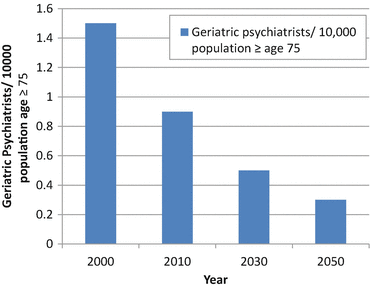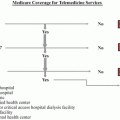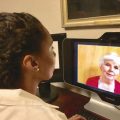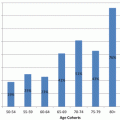Fig. 4.1
Projected numbers of geriatric psychiatrists in the united states. Source (Adapted from [12])
Telepsychiatry, the provision of mental health/psychiatric care via live-two way videoconferencing, is one way to bridge the looming gap between available specialty trained providers and the population in need of services. The foundation and history of telepsychiatry has been extensively covered in Chaps. 1 and 2 and includes the effectiveness of telepsychiatry in geriatric populations . However, training future psychiatrists and geriatric psychiatrists via a structured, well-defined evidence-based curriculum in telepsychiatry remains an area of development. This chapter will review the extant literature describing the prevalence of telepsychiatry in psychiatry training programs; discuss factors promoting telepsychiatry incorporation in clinical curricula and implementation, as well as barriers to effective implementation. This chapter will also inform discussion of telepsychiatry in light of ACGME milestones and competency-based assessments. Lastly, a summary of geriatric telepsychiatry outcome studies from the current literature will be provided which can be used as reference material when developing a geriatric telepsychiatry curricular experience for psychiatry training programs.
4.2 Approach to Training: Adding to Residency Education Foundation and Putting Telepsychiatry in Context
Telepsychiatry has been integrated into clinical care with educational components being facilitated by the release of telepsychiatric competencies [70] including the first telemedicine competencies based on Accreditation Council of Graduate Medical Education milestones movement [13] and the Royal College of Physicians and Surgeons of Canada clinician competency movement [14]. The competencies provide outcomes mainly in the form of skills, with suggested teaching, supervisory, and program evaluation steps. As has been outlined in several publications, few programs have a formal telepsychiatry curriculum, while others feature an informal telepsychiatry experience, including telepsychiatry approaches to child and adolescent care [15–17]. While it has been shown that residents and training directors have an interest in telepsychiatry, certain misconceptions are evident. In a survey of training directors and residents conducted by Hilty et al., 39% of respondents felt that certain cultures will be less accepting of telepsychiatry care. 36% expressed concern that non-verbal cues are missed, and 33% of respondents noted privacy is a problem. Furthermore, over a third of respondents felt telepsychiatry is not as effective as in-person care [18]. It is therefore evident that training should address competencies that are:
4.3 Telepsychiatry in Residency Training Programs: Considerations for Curriculum Development
As has been discussed elsewhere in this book, given the increasing popularity of telepsychiatry initiatives, more emphasis is likely to be placed on exposure and training during residency. Currently the Accreditation Council for Graduate Medical Education (ACGME) does not require residents to train in telepsychiatry, nor do the accrediting bodies in Canada, Australia, New Zealand, and the United Kingdom [19]. Though telepsychiatry experiences are not presently an ACGME requirement, there are several studies that investigate the prevalence of telepsychiatry exposure in training programs, resident and program interest in telepsychiatry, and model curricula. A 2015 article by Hoffman and Kane published data from surveyed psychiatry residency programs, with 46 respondents. Twelve programs (26.1%) reported having telepsychiatry curricula and 21 (45.7%) programs involved their residents either formally or informally in telepsychiatry experiences. 84.4% of the responding programs reported an interest in receiving a sample telepsychiatry curriculum [16]. In a national survey of psychiatry trainees published in 2013, 19% reported direct patient care experiences in telepsychiatry and 21% were offered didactic exposure. Only 18% of psychiatry residents and fellows reported providing direct patient care through telepsychiatry. However, 72% of the respondents were “interested” or “very interested” in telepsychiatry [15]. This data suggests a significant difference between interest (from residents and programs) and actual clinical exposure to telepsychiatry for residents.
The ability to create a telepsychiatry experience may vary by program, given the support provided by the institution, availability of knowledgeable faculty, and the organizational framework of the training program [19]. Just as other facets of training programs evolve, telepsychiatry experiences will likely change, especially with technological advancements [19]. Given the scope of telepsychiatry to meet the ongoing mental health needs of the aging population and continued interest in clinical and educational exposure to telepsychiatry in psychiatric training programs , expansion of the number of programs offering telepsychiatry exposure and increasing the number of residents trained in telepsychiatry is a logical next step.
4.3.1 Learning and Demonstration of Competency
There are a few publications that detail residency program telepsychiatry curricula, which are variable between programs [19, 21]. An experience in telepsychiatry offers several benefits for trainees within a psychiatric residency program. The practice of telepsychiatry provides the opportunity for residents to learn and demonstrate competency in all of the ACGME competencies (which are common across psychiatry subspecialties) and many of the milestones (Table 4.1).
Table 4.1
ACGME core competencies
ACGME competencies | |
|---|---|
Patient care | “Residents must be able to provide patient care that is compassionate, appropriate, and effective for the treatment of health problems and the promotion of health.” |
Medical knowledge | “Residents must demonstrate knowledge of established and evolving biomedical, clinical, epidemiological and social-behavioral sciences, as well as the application of this knowledge to patient care.” |
Practice-based learning and improvement | “Residents must demonstrate the ability to investigate and evaluate their care of patients, to appraise and assimilate scientific evidence, and to continuously improve patient care based on constant self-evaluation and life-long learning.” |
Systems-based practice | “Residents must demonstrate an awareness of and responsiveness to the larger context and system of health care, as well as the ability to call effectively on other resources in the system to provide optimal health care.” |
Interpersonal and communication skills | “Residents must demonstrate interpersonal and communication skills that result in the effective exchange of information and collaboration with patients, their families, and health professionals.” |
Professionalism | “Residents must demonstrate a commitment to carrying out professional responsibilities and an adherence to ethical principles.” |
Most of the competencies are broad-based skills, applicable to all rotations and experiences in psychiatric residency training, including geriatric psychiatry. There has been an increase in dialogue geared towards creating specific objectives and competencies related to telepsychiatry. Both the American Medical Association and American Telemedicine Association have established guidelines and recommendations for telehealth [22]. In a 2015 article, Sunderji and colleagues presented three areas of skill development for residents using telepsychiatry: technical skills, administrative skills, and collaborative skills [19]. A 2016 study by Crawford and colleagues gathered data from interviews of faculty and residents to recommend telepsychiatry-specific skills for competency and presented recommendations for teaching and learning methods . They identified “technical skills; assessment skills; relational skills and communication; collaborative and interprofessional skills; administrative skills; medico-legal skills; community psychiatry and community-specific knowledge; cultural psychiatry skills, including knowledge of indigenous culture; and, knowledge of health systems” [23]. In the current system, most residents will be able to demonstrate all of the ACGME competencies when being evaluated by a supervisor on a telepsychiatry rotation. The creation of telepsychiatry-specific, evidence-based competencies may be an important future direction, particularly in geriatric psychiatry training.
4.3.2 Enhancement of Diversity in Patient Care and Learning
For trainees, telepsychiatry can provide diversity in case exposure by treating patients who are not directly located in the community of their program. Telepsychiatry has applications across a wide array of patient populations including adults, children and adolescents, geriatrics, veterans, college students, nursing home residents, and patients with developmental disabilities [19, 21, 24, 68]. Experience in the core competency of systems-based practice (SBP) is obtained by working in a different system of care outside of the home institution and through utilization of community resources unique to the specific geographical area of the patient. Telepsychiatry has been employed to provide consultations to patients in diverse locations including emergency rooms, outpatient settings (public and private), inpatient hospitals (psychiatric and non-psychiatric), forensic facilities, primary care offices, nursing homes, rural areas, residential centers, and more [15, 19, 21, 24, 25, 58]. ACGME further expands the goals of systems-based practice to include delivering health care services in various settings, advocating for quality care, and working in a team to improve patient assessment, care, and safety (ACGME.org). Psychiatry residents are involved in consultation and collaboration with other providers and staff and documenting the care they provide, which affords the opportunity to display competency in Interpersonal and Communication Skills . Practice-based learning and improvement also incorporates a goal for learning from the use of information technology, which residents develop by not just documenting encounters, but utilizing the telepsychiatry equipment. Patient care and professionalism are important competencies to assess throughout training experiences, and telepsychiatry is no exception. Residents may also learn ethical and medico-legal issues that are unique to telepsychiatry [19, 21].
Telepsychiatry offers an opportunity for attending psychiatrists to work with residents when they are not physically located in the same area, which diversifies teaching faculty. This is particularly important for programs in which geriatric psychiatry faculty may be under-represented. This not only provides the resident an opportunity to observe and learn skills from the teaching psychiatrist, but also provides the faculty an opportunity to teach, which may not be available where they are located. Residents learn new technological skills, are exposed to different psychiatric practice models, gain the flexibility in navigating systems, and a greater understanding of the applicability of a biological–psychological–social/spiritual/cultural model across treatment venues.
4.3.2.1 Increased Interest and Recruitment in Telepsychiatry
An additional significant benefit for patients, residents, and employers is the potential for clinical experiences in telepsychiatry to positively influence career selection. This results in having more psychiatrists providing care via telehealth and therefore increases access to care for patients. Given the shortage of geriatric psychiatrists discussed in the introduction, telepsychiatry has the potential to make a significant impact on access to mental health care for older adults. If residents have a model for utilizing telepsychiatry as part of their practice, receive mentorship in this arena, and experience the positive benefits of telepsychiatry, it could impact resident decisions regarding future career and practice. Reports in the literature highlight that clinical rotations are one of the influential factors on geriatric psychiatry subspecialty choice [26, 27]. After curriculum exposure to telepsychiatry, many residents reported increased overall interest and an increased interest in participating in telepsychiatry in the future [15, 21]. In one study, 90% of the residents agreed with a statement about their telepsychiatry experience increasing their interest in future participation [21]. Another study found that 72% of residents and fellows were interested in telepsychiatry after having direct clinical exposure, but only 29% reported plans to utilize telepsychiatry after training [15]. A study by Chung-Do and colleagues in Hawaii reported that after a 6–12 month telepsychiatry experience, 73% of the 11 trainees went on to use telepsychiatry in their career and practice in rural areas [25]. Given the evidence, it is reasonable to consider that resident telepsychiatry experiences may at a minimum increase interest and potentially influence career choices.
4.3.2.2 Resident Feedback
When creating a telepsychiatry curriculum, it is important to review feedback provided by residents who have been through a telepsychiatry experience in their training program. There are few telepsychiatry curricula that have been evaluated in the literature, with a paucity of data for geriatric psychiatry specific experiences. However, examples in the literature include a study describing resident feedback after performing telepsychiatry child and adolescent consultations at the University of Toronto. Nearly 100% of residents were in agreement that their telepsychiatry exposure was “enjoyable” and “interesting.” Residents reported feeling personally “rewarded” in providing care that improves patient access to mental health services, found benefits in working with a team, and appreciated obtaining insights into other cultures as well as ethical issues that are specific to telepsychiatry. Residents also provided feedback on the involvement of the supervising faculty, reporting that they appreciated being able to discuss the case and literature with attending faculty [21]. Residents participating in a telepsychiatry rotation at the Veterans Administration Medical Center in California provided positive feedback about using instant messaging for communications between the resident, supervising psychiatrist, and a “Telehealth Clinical Technician” [28]. They found it helpful to obtain quick supervision without interrupting the patient care appointment. In this study, a brief elective experience in telepsychiatry received positive feedback and subsequently became incorporated into the rotation requirements [28]. In another survey of residents and fellows, 77% of respondents believed telepsychiatry was an important part of training and 51% felt that direct patient care via telepsychiatry should be required. This survey did not find a correlation between the interest level after exposure to telepsychiatry and the number of patient care hours on a telepsychiatry experience [15]. Taken together, the data suggests that any exposure to telepsychiatry can increase resident interest.
Based on resident feedback in the literature, there are several aspects of a telepsychiatry experience that programs should consider when developing a telepsychiatry curriculum.
- 1.
Introduce unique aspects to telepsychiatry, such as technology and patient care related topics. This could also include discussion about technology support [21].
- 2.
Enhance resident knowledge of current literature describing telepsychiatry studies and outcomes in older adults (Table 4.2) as well as comparative literature on the effectiveness of telepsychiatry vs. in-person care [19, 22, 24]. This is important because, despite the increase in interest from residents after a telepsychiatry clinical experience, one survey found that 40% still did not agree that using telepsychiatry as a treatment modality was equal to an in-person encounter [15].
Table 4.2
Summary of telepsychiatric clinical/outcome studies with older adult patients
Study
N
Location
Technology
Description
Comments
Nursing home
Jones [29]
2
USA
ISDN 128 KBS
Case reports
Able to provide care sooner and staff felt supported
Lee et al. [30]
140
South Korea
T1
Prospective over 2 years: CDR, SBT, BDS
TP = in-person; nurses satisfied; caregiver distress reduced; improved patient behavior
Tang et al. [31]
45
Hong Kong
ISDN 512 KBS
Prospective over 1 year
Satisfaction high with learning curve; some savings in costs
Johnston et al. [32]
40
USA
ISDN 128 KBS
Descriptive study: MMSE
Satisfaction high; efficient use of psychiatrist’s time
Lyketsos et al. [33]
–
USA
Standard telephone
Descriptive study
Reduced hospitalization rate compared to past
Rabinowitz et al. [34]
24
USA
ISDN 384 KBS
Pilot study: DCM
Satisfaction high; communication between providers and staff good
Yeung et al. [35]
9
USA
ISDN 384 KBS
Descriptive study: CGI-I
Satisfaction high; significant improvement in 6/9
Rabinowitz et al. [36]
106
USA
ISDN384 KBS
Descriptive study
Cost and time savings exceeded the start-up costs
Other
Montani et al. [37]
15, medical inpatient
USA
Coaxial cable
TP vs. in-person: MMSE, clock drawing
Nearly equal, with 0.95 correlation; all preferred in-person, though
Menon et al. [38]
24, medical inpatient
USA
Standard telephone
In-person (twice) vs. in-person/video: HDRS, GDS-15
TP as reliable as in-person
Grob et al.[39]
27, veterans home
USA
ISDN 384 KBS
In-person (twice) vs. in-person/video: BPRS, MMSE, GDS
TP as reliable as in-person
Saligari et al. [40]
20, primary care
USA
ISDN 384 KBS
TP vs. in-person: MMSE, GDS
Equal, with MMSE 0.9 and GDS 0.78 correlation
Shores et al. [41]
16, veterans home
USA
T1
TP vs. in-person: DSM-IV, clock drawing
TP equal to in-person
Loh et al. [42]
20, community population
USA
ISDN 384 KBS
TP vs. in-person: MMSE, GDS
Nearly equal with 0.8 correlation for dementia
Cullum et al. [43]
33, primary care
USA
–
TP vs. in-person: MMSE, clock drawing, digit span
High correlations (> 0.60) for all, though only 0.48 for clock drawing
Turvey et al. [44]
118, home
USA
Home monitoring system
Screening for depression with PHQ-2
96.6% completed the screen; helped with triage and treatment
Sheeran et al. [45]
19, home
USA
ISDN 384 KBS
Descriptive: DCM, English, and Spanish
For severe depression, all patients improved to mild depression
Vahia et al. [46]
22, rural community
USA
DSL, 512 KBPS
TP vs. in-person neurocognitive testing in Spanish
No significant differences in TP vs. in-person test performance
- 3.
Provide patient background information and/or access to medical records prior to the encounters [21].
- 4.
Include a follow-up discussion at the completion of the session to enhance the learning experience [21].
- 5.
- 6.
Provide opportunities for residents to observe a telepsychiatry-based clinical interview demonstration by teaching faculty [21].
4.4 Implementation: Making It Work
4.4.1 Communication and Presence
A host of factors affect perception of the telepsychiatry visit and communication by participants [47]. This is particularly relevant when considering implementation for geriatric patient care. The presence of others in the room (e.g., family members, nurses, and tele-coordinators) is important. Many patients feel they are being videotaped when they are not—a big deterrent to disclosure and spontaneity. Other important clues to the patient’s problems are evidenced before they appear on video: the time and behavior of the patient’s arrival; conversations and other interactions with the telemedicine coordinator; and initial anxiety and distraction due to the equipment and/or self-conscious seeing oneself on the screen (if that exists).
A critical variable in communication is telemedicine’s ability to simulate real-time experiences, at least in terms of image and interaction. A speed of transmission of 384 KBS suffices for most everything; the technology must be adequate for the clinical task at hand (e.g., have staff come for an emergently suicidal patient; use a primary care physician (PCP), nurse, or physician extender to evaluate for tremor). A concept that bears on communication is presence, defined as “ … the fact or condition of being at the specified or understood place” [48]. The physical, virtual, and imaginal environments affect presence. In a physical environment, informational cues may be incorporated into conversation without conscious awareness (e.g., a patient walks in a reticent way). Participants in the virtual environment created by telemedicine may not realize all cues in the physical environment—so being observant and listening carefully may be more important [47, 48]. Videoconferencing provides “enough” of the physical environment to facilitate decision-making one-on-one and a “social presence” for participants to share a virtual space, get to know one another, and discuss complex issues [49].
4.4.2 Adapting Telepsychiatry: The Approach and Specifics Related to Patient Care and Other Competencies
The challenge of meaningful assessment of learner competence has stimulated interest in the Dreyfus and Dreyfus Model , a framework for assessing skill acquisition that describes developmental stages beginning with novice and progressing through advanced beginner, competent, proficient, expert, and master [50]. Although many educators have adopted this model, a lack of consensus about its adaptation to clinical medicine has been documented [51]. Hilty et al. developed telepsychiatry competencies aligned along ACGME domains of patient care, medical knowledge, practice-based learning and improvement, systems-based practice, professionalism, and interpersonal skills and communication [13, 52]. Key telepsychiatry competencies were defined by using milestone levels with the Dreyfus model :
Level 1—novice (medical student) –> novice resident
Level 2—advanced beginner (first-year resident) –> second year resident
Level 3—competent (senior resident)
Level 4—proficient (beyond Milestones; above average graduating resident, fellow and/or attending)
Level 5—expert (beyond Milestones; intuitive problem-solver who exceeds principle-based solutions) [50].
This was further simplified to three levels: Novice or Advanced Beginner (e.g., advanced medical student, early resident, or other trainees); Competent/Proficient (e.g., advanced resident, graduating resident, faculty, attending, or interdisciplinary team member); and Expert (e.g., advanced faculty, attending, or interdisciplinary team member). The following suggestions or examples may be considered to incorporate a competency-based approach to telepsychiatry training (Table 4.3):
Informed consent: verbal or written, depending on the state; option not to continue with the telepsychiatry evaluation is discussed.
Contextualized history if less familiar with the location (e.g., aware of geographic and cultural specificity for Native Americans).
Privacy and confidentiality expectations are similar to in-person but be aware of pitfalls with technologies (e.g., cellular phones are not private; Gmail is not HIPAA compliant).
Language/interpreter ability is more of an issue with telepsychiatry, as inputting a professional (rather than a convenient family member) is easier [53].
Adapting to the technology involves several dimensions: project self 15% more (voice/animation) and use replacement behaviors for offering a tissue or shaking hands on greeting.
Familiarity with microphone, camera and when needed, a 2nd camera is helpful. Pursuant to the technical skill level of the clinician further optimization of hardware, software, and accessories may be based on context (rather than depending on technical assistance or coordinators). Far end control of cameras and equipment minimizes dependence on remote site patient and staff.
A geriatric patient evaluation by telepsychiatry could further include a spouse, an adult child, or caregiver who participates in the evaluation in-person or via telephone.
Table 4.3
Telepsychiatry (TP) competencies related to patient care, system- and practice-based learning, professionalism, communication, knowledge, and technology
Area/topic | Novice or advanced beginner | Competent/proficient | Expert |
|---|---|---|---|
(e.g., advanced medical student, early resident, other trainees) | (e.g., advanced resident/graduating resident/faculty/attending/interdisciplinary team member) | (e.g., advanced faculty/attending/interdisciplinary team member) | |
Patient care | |||
History-taking | Obtains standard history | Obtains informed consent for telehealth (checks state regulations to see if form needed; discusses option not to perform telepsychiatry encounter) Obtains contextualized history (e.g., is aware of geographic and cultural specificity)
Stay updated, free articles. Join our Telegram channel
Full access? Get Clinical Tree
 Get Clinical Tree app for offline access
Get Clinical Tree app for offline access

| |




